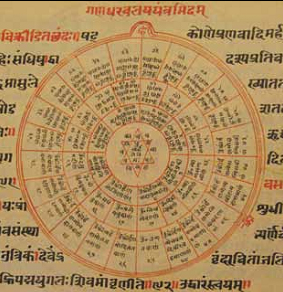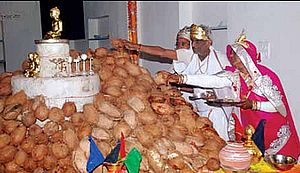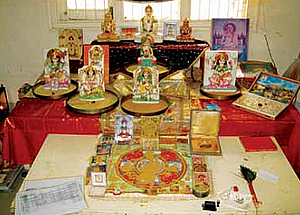
Centre of Jaina Studies Newsletter: SOAS - University of London
Digambara Jains believe that in the second century CE, when the entirety of the teachings of Mahāvīra (āgama) were on the brink of being forgotten, the monk who possessed the remaining memory of these teachings, Dharasena, tasked two of his monastic disciples, the monks Puṣpadanta and Bhūtabali, to record the teachings in the text that became known as the Ṣaṭkhaṇḍāgama. Before his death, Puṣpadanta is said to have recorded the text's first 177 verses (śloka), placing at the outset a Prakrit benediction (maṅgala) praising the five supreme lords (pañcaparameṣṭhin) of Jainism. Bhūtabali, then, is said to have completed the remainder of the text, opening the fourth chapter, the Vargaṇā-khaṇḍa, and the sixth chapter, the Mahābandha, with another Prakrit benediction of forty-four lines.[1] For Jains of all sects today, the maṅgala at the outset of the Ṣaṭkhaṇḍāgama is instantly recognizable as the most popular Jain invocation, known by various names, including the ṇamokār mantra and the nokār mantra. A great deal of literature has been devoted to this mantra, which is recited in nearly every Jain ritual and understood to be eternal and all-powerful.
The maṅgala that opens the fourth and sixth chapters of the Ṣaṭkhaṇḍāgama, on the other hand, has received very little scholarly attention, but my fieldwork in North India in 2013 has shown that it is an important part of Jain ritual culture. This benediction includes a string of praises to practitioners who have achieved certain superhuman powers (labdhi, ṛddhi) such as the ability to fly or generate an unlimited amount of food.[2] The section of the maṅgala devoted to those with certain powers of healing, for example, reads:
Praise to [the advanced practitioners] whose touch is medicinal, whose phlegm, saliva, etc. is medicinal, whose sweat is medicinal, whose urine, excrement, and semen is medicinal, who can heal with all parts of their bodies.[3]
Because the ṇamokār mantra and this set of praises are both first found in the Ṣaṭkhaṇḍāgama, and the ṇamokār mantra has been studied extensively, while the maṅgala of superhuman powers (termed here the "ṛddhi maṅgala") has been largely ignored in scholarship, I think of this maṅgala of superhuman powers as the ṇamokār mantra's forgotten brother. Terming the ṛddhi maṅgala "forgotten" may not be strictly correct, however, since it, like its "brother," eventually became understood as a mantra and it is now recited daily by both lay and ascetic Jains. The ṛddhi maṅgala may not be as omnipresent as the ṇamokār mantra in Jain ritual, but it is still commonly used, and has become particularly associated with two different functions: initiating monks and nuns into Mahāvīra's mendicant lineage, and healing practitioners with various physical ailments. My brief analysis of these two functions here can serve as an introduction to one of the many Jain mantras "forgotten" by scholarship, if not to practicing Jains.

Figure 1. Detail of a folio from a late-nineteenth-century manuscript
of Vasubindu’s Pratiṣṭhāpāṭha showing the gaṇadharvalaya. Bābā
Dulicandjī Baḍā Mandir Śāstra Bhaṇḍār, Jaipur. Manuscript no. 486.
The early texts of both the Śvetāmbaras and Digambaras associate superhuman powers in this mantra with the disciples (gaṇadhara) of the tīrthaṅkaras.[4] For this reason, Digambaras have termed the ṛddhi maṅgala the "gaṇadharavalaya mantra," or the "mantra of the ring of disciples." The "ring" refers to circular ritual diagrams (valaya) on which the mantra is inscribed. To my knowledge, the earliest dateable source to outline a valaya of this name is the Digambara Amitagati's early eleventh-century text on lay ritual conduct, the Śrāvakācāra.[5]
While Amitagati groups the gaṇadharavalaya with other ritual diagrams, explaining that meditation (dhyāna) on any of these diagrams can destroy karma,[6] other texts, both Digambara and Śvetāmbara, use this valaya for a more unique purpose: legitimating monks and nuns. Because the gaṇadharavalaya is thought to praise the tīrthaṅkaras' disciples, its veneration can link worshipers with the original Jain mendicants. Today, to my knowledge, Digambaras of all lineages worship large gaṇadharavalayas made of colored powdered in the days prior to initiation ceremonies (dīkṣā). For the dīkṣā ceremony I witnessed in Kekḍī, Rajasthan, in November 2013, the three Jains taking initiation under the Bīsapanthī Ācārya Vairāgyanandī one as a sādhvī, one as a kṣullaka, and one as a muni spent the eight days preceding their initiations performing the Gaṇadhara Valaya Pūjā, following a Hindi translation of the sixteenth-century Sanskrit pūjā composed by Bhaṭṭāraka Śubhacandra.[7] In this pūjā, the worshippers not only recited the gaṇadharavalaya mantra the series of praises to practitioners who have achieved superhuman powers they also recited verses praising each of the 1,452 disciples of the tīrthaṅkaras. As each praise was recited, the initiands placed coconuts on a colored diagram of the gaṇadharavalaya, with each offering honoring the original disciples of the founders of Jainism and establishing themselves as the successors of their tradition (see Figure 2).
The gaṇadharavavalaya has also been used to consecrate Digambara temple images (pratimā) of monks and nuns. Medieval Digambara handbooks on image consecration (pratiṣṭhā) prescribe the worship of different ritual diagrams on the days before temple images are established (pratiṣṭhita) in the temple, explaining that icons of an ācārya or another mendicant (ācāryādi) require the worship of the gaṇadharavalaya. Descriptions of the diagram in texts such as Nemicandra's Pratiṣṭhātilaka (ca. 1200 CE),[8] Āśādhara's Pratiṣṭhāsāroddhāra (13th century),[9] and Jayasena's Pratiṣṭhāpāṭha (14th 15th century?)[10] correspond almost exactly to that of Amitagati: The center of the gaṇadharavalaya contains a star (ṣaṭkoṇa) around which two Sanskrit mantras, "apraticakre phaṭ," and "vicakrāya svāha" are inscribed, circling in opposite directions. The forty-four Prakrit praises of the ṛddhi maṅgala of the Ṣaṭkhaṇḍāgama, along with four additional praises, fill forty-eight lotus petals surrounding the central star (Figure 1). Just as in dīkṣā ceremonies today, it seems that these medieval texts understood that worshipping the gaṇadharvalaya allowed an image or a mendicant to "become" a disciple of the tīrthaṅkaras.
Perhaps because of this understanding that the mantra could connect images and mendicants to the original disciples of the tīrthaṅkaras, by at least the thirteenth century, the Prakrit praises to ascetics with superhuman powers began to be understood as the first section (pīṭha) of the Śvetāmbara sūrimantra, or the mantra imparted to Śvetāmbara monks when promoted to the highest rank of mendicancy (ācārya, sūri).[11] In his thirteenthcentury Sanskrit text the Mantrarājarahasya (MRR), the Śvetāmbara ācārya Siṃhatilakasūri outlines how to construct cloth ritual diagrams (paṭa) of the sūrimantra that are imparted to sūris upon their promotions and then worshipped daily with scented sandalwood powder (vāsakṣepa). Ācāryas today continue to worship their sūrimantra paṭas daily, and some ācāryas undertake elaborate, multiple-day worship ceremonies of the diagrams for each of the five sections of the sūrimantra (Image 3).[12] Just like Digambara mendicants, Śvetāmbara mendicant leaders, through the worship of this diagram, can connect themselves to the original leaders of their community. While modern Śvetāmbara diagrams today differ considerably from Digambara gaṇadharvalayas, the latter may have served as a model for the former. In one of his descriptions of a sūrimantra paṭa, Siṃhatilakasūri outlines the exact same diagram as the gaṇadharavalaya found in Digambara image consecration manuals.[13]

Figure 2. Initiands place coconuts on a
gaṇadharavalaya made of colored powder.
Kekḍī, Rajasthan, November 2013.
Photo: Paras Jain and Jitendra Jain for
Khushbu Films.
All Rights Reserved.

Figure 3. A shrine established by Ācārya
Nandighoṣasūri of the Tapā Gaccha for an eightday worship ceremony of the fourth section (pīṭha)
of the sūrimantra. An icon of the deity Gaṇipīṭaka,
established at the front and center of the shrine,
presides over the fourth section of the mantra.
Ahmedabad, June 2013. Photo: Ellen Gough
The ṛddhi maṅgala did not merely become associated with linking practitioners to the tīrthaṅkaras' disciples, however. Perhaps because a large section of the mantra praises ascetics who have curative powers, this mantra has developed a reputation as a miracle cure for all types of maladies. Siṃhatilakasūri notes that the praises at the outset of the sūrimantra to the jinas with different types of clairvoyance (avadhi) can cure fevers and diseases of the head, ears, and eyes.[14] The gaṇadharavalaya that is part of the Digambara śāntidhāra, a hymn recited to pacify negative influences, makes these same claims.[15] Indeed, amongst both image-worshipping sects, the belief in the healing power of these praises persists to this day. A Śvetāmbara nun in Ahmedabad, for example, told me that she had come out of a coma because of the strength she developed reciting the "labdhi pada" of forty-eight lines, a mantra identical to the Digambara gaṇadharavalaya.[16]
The ṛddhi mantra of forty-eight lines has also been used as a medicinal charm when paired with the verses of Mānatuṅga's Sanskrit Bhaktāmara Stotra (ca. sixth century?), the most popular Jain praise poem. M.A. Dhaky and Jitendra Shah estimate that at least by the fourteenth century, a line of the gaṇadharavalaya (a ṛddhi), a mantra, and a diagram on which the mantra and ṛddhi are inscribed had become associated with each verse of the Bhaktāmara Stotra.[17] These yantras have become extremely popular and are credited with curing all sorts of problems. Both Śvetāmbara and Digambara temples have been dedicated to these yantras, and practitioners like Dr Manju Jain, a counselor at the Spiritual Healing Center in Nagpur, Maharashtra, have published manuals outlining how meditation on these yantras and recitation of the ṛddhis and verses of the Bhaktāmara Stotra can relieve the symptoms of various ailments, from depression to kidney failure to cancer.[18] While the Śvetāmbara version of the Bhaktāmara Stotra contains only forty-four verses, and the Digambara version contains forty-eight, both sects associate all forty-eight praises to superhuman powers that constitute the gaṇadharavalaya with the stotra. This suggests that Śvetāmbaras adopted this association from Digambaras, but more research needs to be done on the origins of this association. Indeed, much more research needs to be done on all of the thousands of Jain mantras forgotten by scholarship, but hopefully this report has made a small contribution to the ongoing effort to place the study of Jain mantraśāstra on par with its Buddhist and Hindu counterparts.
Ellen Gough is a PhD candidate at Yale University, where she is completing her dissertation, "Making a Mantra: Jain Superhuman Powers in History, Ritual, and Visual Culture." A SOAS alumna, she was holder of the 2007 Jain Spirit Fellowship in Jaina Studies, and awarded the IOJ sponsored Centre of Jaina Studies MA Dissertation Prize 2008. In August 2015, Gough will join the faculty of the Department of Religion at Emory University.
For the early ninth-century account of Puṣpadanta and Bhūtabali composing Ṣaṭkhaṇḍāgama, see Dhavalā 1.1 in Ṣaṭkhaṇḍāgama (Vol. 1: 71-72).
On these superhuman powers, see Kristi Wiley, "Supernatural Powers and their Attainment in Jainism," in Yoga Powers: Extraordinary Capacities Attained Through Meditation and Concentration, ed. Knut A. Jacobsen (Leiden & Boston: Brill, 2012); and Peter Flügel, "Sacred Matter: Reflections on the Relationship of Karmic and Natural Causality in Jaina Philosophy," Journal of Indian Philosophy 40, 2 (2012): 125-133.
"ṇamo āmosahipattāṇaṃ, ṇamo khelosahipattāṇaṃ, ṇamo jallosahipattāṇaṃ, ṇamo viṭṭhosahipattāṇaṃ, ṇamo savvosahipattāṇa ṃ"(Ṣaṭkhaṇḍāgama 4.30-34; Mahābandha 1.30-34).
The Śvetāmbara Aupapātika Sūtra 24 associates the powers only with the followers (Pkt. aṃtevāsī) of Mahāvīra. See Amar Muni, ed. & Surendra Bothara, trans., Illustrated Aupapatik Sutra (New Delhi: Padma Prakashan, 2003), 56-65. The Digambara Trilokaprajñapti 4.961-1091 associates 64 types of superhuman powers with the 1,452 disciples of all the tīrthaṅkaras. See Tiloyapaṇṇatti (Trilokaprajñapti), Part 1, Second Edition, A.N. Upadhye & Hiralal Jain, ed., Pt. Balchandra, trans. (Solapur: Jain Saṃskṛti Saṃrakṣak Saṃgh, 1956), 270-286.
Śrāvakācāra 15.46-48 in Hīrālāl Śāstrī, comp. & trans., Śrāvakācāra Saṃgraha, Vol 1 (Śolāpur: Jain Saṃskṛti Saṃrakṣak Saṃgh, 2001), 412.
See Āryikā Rāj & Āryikā Kṣamā, Bṛhad Gaṇadhara Valaya Vidhāna, ed. Ācārya Guptinandī (Jaipur: Śārdā Prakāśan, 2003).
Pratiṣṭhātilaka of Nemicandra, ed. Āryikā Jñānamatī (Hastinapur: Digambar Jain Trilok Śodh Saṃsthān, 2006), 328-331.
Pratiṣṭhāsāroddhāra of Āśādhara, ed. Manoharlāl Śāstrī (Bombay: Jaingranth-Uddhārak Kāryālay, 1917), 230a-231a.
Jayasena, Pratiṣṭhāpāṭha, ed. Hīrācaṃd Nemacaṃd Dośī (Śolāpur: Śeṭh Hīrācand Nemacand Dośī, 1925), 226b-227a
Paul Dundas, "Becoming Gautama: Mantra and History in Śvetāmbara Jainism," in Open Boundaries: Jain Communities and Cultures in Indian History, ed. John E. Cort (Albany: State University of New York Press, 1998), is the most comprehensive study of the sūrimantra in English.
For an example of a Gujarati booklet used today for the worship of each of the five sections of the sūrimantra, see Ācārya Somacandrasūri, Śrīsūrimantrapañcaprasthāna Prārambhavidhi (Surat: Śrī Rāṃder Road Jain Saṃgh, 2013).
ṣaṭkoṇe'praticakrāyantraṃ ṣaḍadhikadaśadvyadhitriṃśat | antardalaṃ stutipadī digantare gaṇabhṛtāṃ valayam || MRR 69 in Muni Jambuvijaya, ed., Sūrimantrakalpasamucchaya, Part 1 (Mumbai: Jain Sāhitya Vikās Maṇḍal, 1969), 8. "Inside a triangle [inscribe] the apraticakrā yantra. In the different directions inside the petals of a lotus, [inscribe] the 48 verses of praise, the gaṇadhara valaya." For a discussion of the Śvetāmbara use of this diagram and modern replications of this maṇḍala, which are identical to Digambara gaṇadharavalaya yantras worshiped today, see Muni Jambuvijaya, Sūrimantrakalpasamucchaya, Part 2 (Mumbai: Jain Sāhitya Vikās Maṇḍal, 1977), 299-304; yantras no. 1 & 16.
Ācārya Vairāgyanandī, comp., Paṃcāmṛt Abhiṣek Pāṭh evaṃ Baḍī Śāntidhārā (Tonk, Rajasthan, n.p., 2011), 34.
The mantra she recited is found in Muni Mahāsenavijaya, ed., Labdhitaṇā Bhaṇḍār (Tarapur, Gujarat: Śrī Nemi Uday Candrasenasūri Smṛti Traṣṭ, 2010), 20-24. Mahāsenavijaya (2010: 20-24).
Madhusūdan Ḍhākī and Jitendra Śāh, Mānatuṅgācārya aur unke Stotra (Ahmedabad: Śārdāben Cimanbhāī Education Research Centre, 1997), 3.
 Dr. Ellen Gough
Dr. Ellen Gough